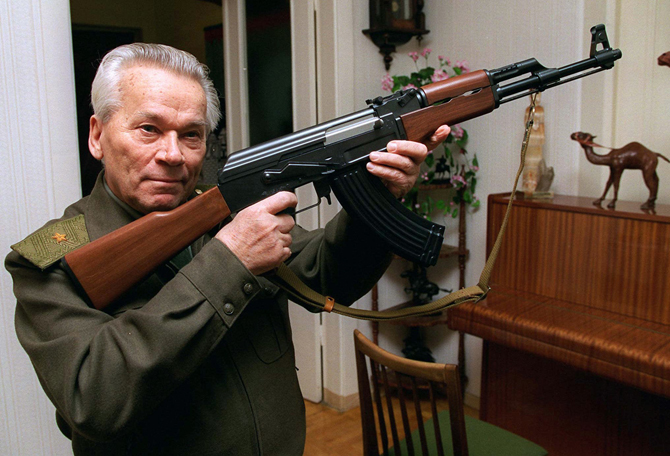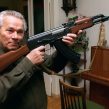
Russia Tires of the Kalashnikov Rifle
Publication: Eurasia Daily Monitor Volume: 8 Issue: 188
By:

The Russian defense ministry and defense industry have continued to trade insults as they quarrel over how to spend increased budget allocations earmarked to rearm the military with modern weapons. To keep up the pressure, the defense ministry has been using leaks to the press to stress the urgent need for change to redress the backwardness of its present forces. Top symbols of old greatness are no longer taboo – the Kalashnikov AK assault rifle has also been declared outdated.
The defense ministry has refused to procure any new AK-74s or its modifications this year or in 2012, or possibly ever again. Defense ministry sources were quoted as saying “there are too many AK-74s in arsenals already and we want a new rifle as reliable as the AK, but more accurate and with a longer range.” The Izhmash factory in Izhevsk in the Urals – the home of the inventor of the AK, Mikhail Kalashnikov – announced it will soon offer the military a new improved rifle, while continuing to make sports and hunting rifles as well as AKs for export. Kalashnikov (92) apparently has not been told the Russian military considers his fabled rifle obsolete and does not want it anymore, “since he may not survive the shock” (Izvestiya, September 26).
Indeed, the news shocked many Russians who have for generations proudly believed the AK to be a symbol of Russian ingenuity, inferior to none. The original AK-47 7.62mm caliber was a wonderful weapon, cheap, effective and highly reliable. The 1974 modernization – the AK-74 – used a much less effective 5.45mm bullet and never gained the international acclaim of the AK-47. The Russian military has been thinking about a replacement for some time, but was hesitant to challenge a national symbol. Defense Minister Anatoliy Serdyukov has personally intervened to correct the present controversy: “The army is not discharging the AK-74; it will still be in use, but we already have some 17 million stockpiled in arsenals and will not procure them anymore.” Serdyukov hopes to modernize some AKs from the stockpile, while selling or lending rifles “to those, who do not need a better weapon” (Komsomolskaya Pravda, October 6).
Despite its vast armada of tanks, jets and nuclear missiles, acquired during the Cold War, the Russian army continues still to be in essence a peasant-style mass military force with reliable, cheap, unsophisticated weapons and equipment – a force of a high birthrate nation Russia once was some generations ago, ready to accept heavy war casualties. Of course, now Russia’s birthrate is low, the population is shrinking and with it the number of available conscripts. In 2009, after compulsory military service was decreased from two years to one, 575,000 conscripts were called up. In 2010 some 540,000 conscripts were called up. This year, 218,000 was drafted in the spring and plans have been announced to call up only 135,000 in the fall – 353,000 in total. In 2012, conscription may decrease further to less than 300,000 per year, while officially the overall official manpower strength of the armed forces remains at one million (Izvestiya, October 2).
The true number of active service personnel in Russia’s armed forces and multiple security services is a state secret, but practically all independent observers agree it is less than the announced one million and may soon decrease much further (EDM, October 12). Serdyukov has told journalists the decrease in conscripts will lead to the creation of a more professional armed force manned by contract volunteer soldiers (RIA Novosti, October 2). Next January, contract soldiers’ pay will increase from 28,000 rubles to 35,000 rubles a month ($900 to $1,130). The defense ministry seems to hope that this hike may encourage conscripts ending one year compulsory service to volunteer to stay en masse. Defense ministry officials have promised a new system will be created to select the best candidates to be contract soldiers, evaluate their capabilities, reeducate and promote them to specialist and sergeant posts. A career roadmap for sergeants will be created in Russia of at least five levels (modeled on the US system) topped with the creation of the position of the Main Sergeant of the Armed Forces (Interfax, October 5).
According to Serdyukov, there are today 180,000 contract soldiers and sergeants in the armed forces and not all of them are good enough to become the backbone of the new professional military (VPK, October 12). According to Colonel (retired) Vitaliy Shlykov, who is an adviser on military reform to the defense ministry, to fill the gap in the ranks, the number of contract soldiers must increase to some 400,000, which is virtually impossible anytime soon: “Even 35,000 rubles a month will not help – the FSB, FSO and other security services will offer 40,000 a month ($1,290) and get the best.” According to Shlykov, the inevitable massive decrease in the number of servicemen is not a tragedy: “It is better to have half a million well-trained, able-bodied soldiers, then a million that includes the lame, the sick and criminals, all forced to serve together” (Izvestiya, October 2).
In any case, for the first time in Russian history, military chiefs are forced to indeed secure the lives and wellbeing of the rank and file, try to train them better, acquire modern weapons and replace barracks with family apartments (Interfax, October 5). The task is daunting: the army’s weapons are obsolete, there is no modern body armor whatsoever or helmets, workable computerized command and control systems are nonexistent, communications equipment is World War II quality, the only workable unmanned aerial vehicles (UAVs) are the couple of dozen imported from Israel, according to Serdyukov (Komsomolskaya Pravda, October 6).
The defense budget is planned to increase dramatically, but the additional money will be spread out on increasing pay, procuring new conventional weapons and at the same time building a new generation of highly expensive strategic nuclear weapons aimed at the US and a new national BMD defense system – or the so called Air-Space Defense. It is clear the nuclear deterrent is the main priority – aimed at keeping the US and other Western influence out of the former Soviet space as Vladimir Putin attempts to rebuild a Eurasian superstate (EDM, October 6). Despite the seemingly good intentions of Serdyukov, the outcome of the conventional forces radical reform and rearmament is questionable.




